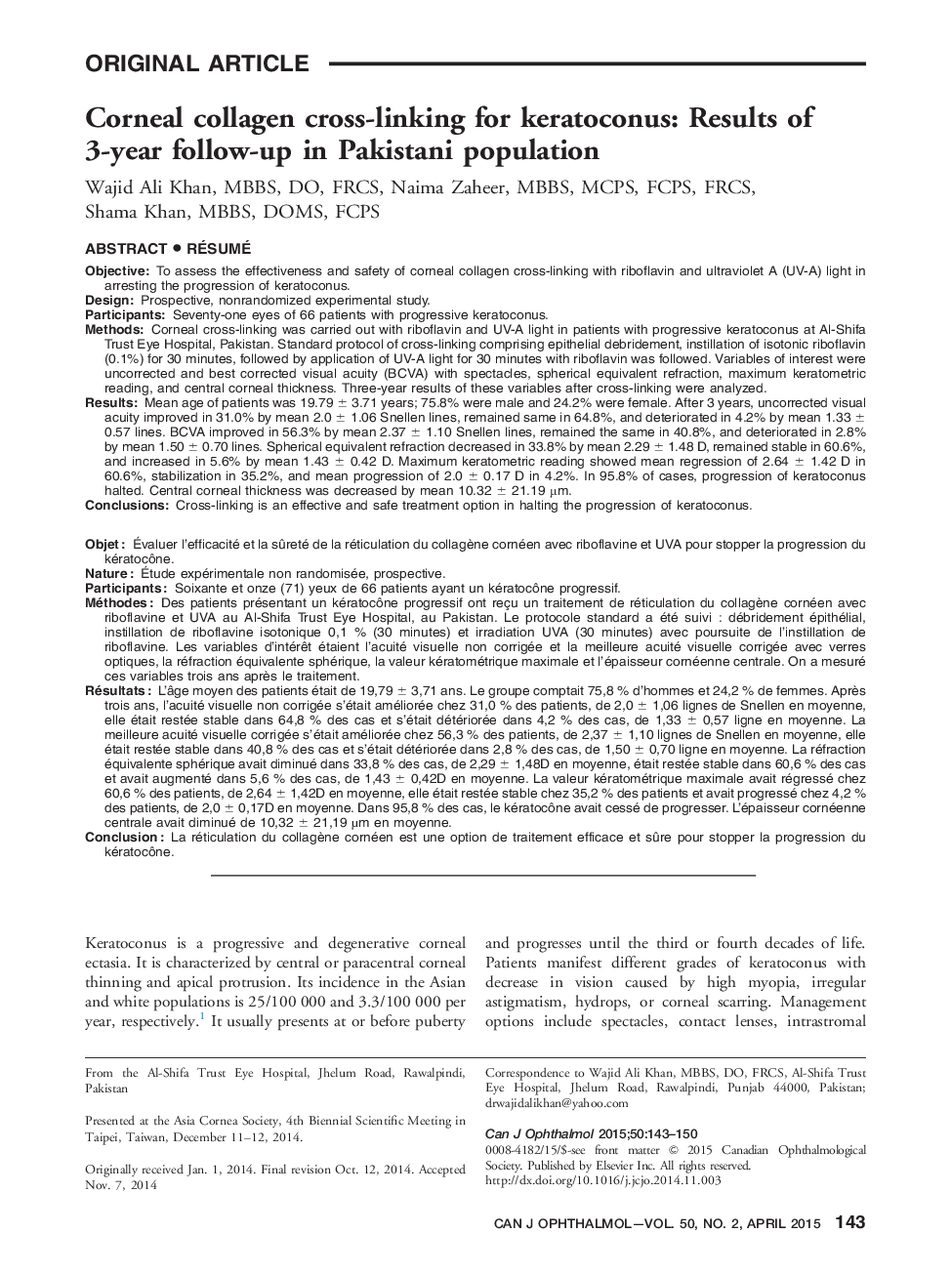| کد مقاله | کد نشریه | سال انتشار | مقاله انگلیسی | نسخه تمام متن |
|---|---|---|---|---|
| 4009252 | 1602397 | 2015 | 8 صفحه PDF | دانلود رایگان |
ObjectiveTo assess the effectiveness and safety of corneal collagen cross-linking with riboflavin and ultraviolet A (UV-A) light in arresting the progression of keratoconus.DesignProspective, nonrandomized experimental study.ParticipantsSeventy-one eyes of 66 patients with progressive keratoconus.MethodsCorneal cross-linking was carried out with riboflavin and UV-A light in patients with progressive keratoconus at Al-Shifa Trust Eye Hospital, Pakistan. Standard protocol of cross-linking comprising epithelial debridement, instillation of isotonic riboflavin (0.1%) for 30 minutes, followed by application of UV-A light for 30 minutes with riboflavin was followed. Variables of interest were uncorrected and best corrected visual acuity (BCVA) with spectacles, spherical equivalent refraction, maximum keratometric reading, and central corneal thickness. Three-year results of these variables after cross-linking were analyzed.ResultsMean age of patients was 19.79 ± 3.71 years; 75.8% were male and 24.2% were female. After 3 years, uncorrected visual acuity improved in 31.0% by mean 2.0 ± 1.06 Snellen lines, remained same in 64.8%, and deteriorated in 4.2% by mean 1.33 ± 0.57 lines. BCVA improved in 56.3% by mean 2.37 ± 1.10 Snellen lines, remained the same in 40.8%, and deteriorated in 2.8% by mean 1.50 ± 0.70 lines. Spherical equivalent refraction decreased in 33.8% by mean 2.29 ± 1.48 D, remained stable in 60.6%, and increased in 5.6% by mean 1.43 ± 0.42 D. Maximum keratometric reading showed mean regression of 2.64 ± 1.42 D in 60.6%, stabilization in 35.2%, and mean progression of 2.0 ± 0.17 D in 4.2%. In 95.8% of cases, progression of keratoconus halted. Central corneal thickness was decreased by mean 10.32 ± 21.19 µm.ConclusionsCross-linking is an effective and safe treatment option in halting the progression of keratoconus.
RésuméObjetÉvaluer l’efficacité et la sûreté de la réticulation du collagène cornéen avec riboflavine et UVA pour stopper la progression du kératocône.NatureÉtude expérimentale non randomisée, prospective.ParticipantsSoixante et onze (71) yeux de 66 patients ayant un kératocône progressif.MéthodesDes patients présentant un kératocône progressif ont reçu un traitement de réticulation du collagène cornéen avec riboflavine et UVA au Al-Shifa Trust Eye Hospital, au Pakistan. Le protocole standard a été suivi : débridement épithélial, instillation de riboflavine isotonique 0,1 % (30 minutes) et irradiation UVA (30 minutes) avec poursuite de l’instillation de riboflavine. Les variables d’intérêt étaient l’acuité visuelle non corrigée et la meilleure acuité visuelle corrigée avec verres optiques, la réfraction équivalente sphérique, la valeur kératométrique maximale et l’épaisseur cornéenne centrale. On a mesuré ces variables trois ans après le traitement.RésultatsL’âge moyen des patients était de 19,79 ± 3,71 ans. Le groupe comptait 75,8 % d’hommes et 24,2 % de femmes. Après trois ans, l’acuité visuelle non corrigée s’était améliorée chez 31,0 % des patients, de 2,0 ± 1,06 lignes de Snellen en moyenne, elle était restée stable dans 64,8 % des cas et s’était détériorée dans 4,2 % des cas, de 1,33 ± 0,57 ligne en moyenne. La meilleure acuité visuelle corrigée s’était améliorée chez 56,3 % des patients, de 2,37 ± 1,10 lignes de Snellen en moyenne, elle était restée stable dans 40,8 % des cas et s’était détériorée dans 2,8 % des cas, de 1,50 ± 0,70 ligne en moyenne. La réfraction équivalente sphérique avait diminué dans 33,8 % des cas, de 2,29 ± 1,48D en moyenne, était restée stable dans 60,6 % des cas et avait augmenté dans 5,6 % des cas, de 1,43 ± 0,42D en moyenne. La valeur kératométrique maximale avait régressé chez 60,6 % des patients, de 2,64 ± 1,42D en moyenne, elle était restée stable chez 35,2 % des patients et avait progressé chez 4,2 % des patients, de 2,0 ± 0,17D en moyenne. Dans 95,8 % des cas, le kératocône avait cessé de progresser. L’épaisseur cornéenne centrale avait diminué de 10,32 ± 21,19 µm en moyenne.ConclusionLa réticulation du collagène cornéen est une option de traitement efficace et sûre pour stopper la progression du kératocône.
Journal: Canadian Journal of Ophthalmology / Journal Canadien d'Ophtalmologie - Volume 50, Issue 2, April 2015, Pages 143–150
